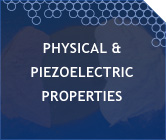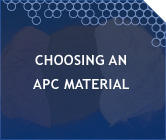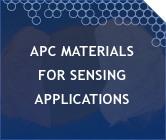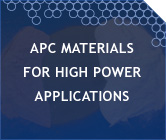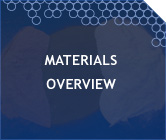Physical and Piezoelectric Properties of APC Materials
Download Materials Chart as PDF
| APC Material: |
840 |
841 |
850 |
854 |
855 |
860 |
880 |
| Navy Type Equivalent |
Navy I |
Hybrid |
Navy II |
Navy V |
Navy VI |
Porous |
Navy III |
| Relative Dielectric Constant |
| KT |
1275 |
1375 |
1900 |
2750 |
3300 |
1200 |
1050 |
| Dielectric Dissipation Factor (Dielectric Loss(%)* |
| tan δ |
0.60 |
0.40 |
≤ 2.00 |
≤ 2.00 |
≤ 2.50 |
≤2.00 |
0.40 |
| Curie Point (°C)** |
| Tc |
325 |
320 |
360 |
250 |
200 |
360 |
310 |
| Electromechanical Coupling Factor |
| kp |
0.59 |
0.60 |
0.63 |
.66 |
0.68 |
0.50 |
0.50 |
| k33 |
0.72 |
0.68 |
0.72 |
.68 |
0.76 |
0.45 |
0.62 |
| k31 |
0.35 |
0.33 |
0.36 |
- |
0.40 |
- |
0.30 |
| k15 |
0.70 |
0.67 |
0.68 |
- |
0.66 |
- |
0.55 |
| |
| d33 |
290 |
300 |
400 |
600 |
630 |
380 |
215 |
| -d31 |
125 |
109 |
175 |
260 |
276 |
- |
95 |
| d15 |
480 |
450 |
590 |
625 |
720 |
- |
330 |
| Piezoelectric Voltage Constant (10-3 Vm/N or 10-3 m2/C) |
| g33 |
26.5 |
25.5 |
24.8 |
25.5 |
21.0 |
38.0 |
25.0 |
| -g31 |
11.0 |
10.5 |
12.4 |
- |
9.0 |
- |
10.0 |
| g15 |
38.0 |
35.0 |
36.0 |
- |
27.0 |
- |
28.0 |
| Young's Modulus (1010 N/m2) |
| YE11 |
8.0 |
7.6 |
6.3 |
6.0 |
5.9 |
- |
9.0 |
| YE33 |
6.8 |
6.3 |
5.4 |
5.2 |
5.1 |
- |
7.2 |
| Frequency Constants (Hz*m or m/s) |
| NL (longitudinal) |
1524 |
1700 |
1500 |
- |
1390 |
- |
1725 |
| NT (thickness) |
2005 |
2005 |
2040 |
2000 |
2079 |
1390 |
2110 |
| NP (planar) |
2130 |
2055 |
1980 |
1972 |
1920 |
1900 |
2120 |
| Density (g/cm3) |
| ρ |
7.6 |
7.6 |
7.6 |
7.6 |
7.6 |
6.6 |
7.6 |
| Mechanical Quality Factor |
| Qm |
500 |
1400 |
80 |
70 |
65 |
50 |
1000 |
| Acoustic Impedance (Mrayl) |
| Za |
- |
- |
31.5 |
- |
- |
16.5 |
- |
| APC Material: |
842 |
844 |
851
|
881 |
Type I |
Type II |
Type III |
| |
| Equivalent APC Material |
Type 1 |
|
Type II
|
Type III |
Type I |
Type II |
Type III |
| Relative Dielectric Constant |
| KT |
1375 |
1500 |
1950
|
1030 |
1300 |
1800 |
1000 |
| Dielectric Dissipation Factor (Dielectric Loss(%)* |
| tan δ |
0.45 |
0.40 |
1.50
|
0.40 |
1.0 |
2.0 |
1.0 |
| Curie Point (°C)** |
| Tc |
325 |
320 |
360
|
310 |
320 |
300 |
300 |
| Electromechanical Coupling Factor (%) |
| kp |
0.65 |
0.68 |
0.71
|
0.58 |
0.60 |
.65 |
.55 |
|
kt
|
0.48
|
0.48
|
0.51
|
0.46
|
0.40 |
.40 |
.40 |
| Piezoelectric Charge Constant (10-12 C/N or 10-12 m/V) |
| d33 |
300 |
300 |
400
|
260 |
275 |
375 |
200 |
| Piezoelectric Voltage Constant (10-3 Vm/N or 10-3 m2/C) |
| g33 |
26.3 |
24.5 |
24.8
|
26.7 |
26 |
25 |
26 |
| Young's Modulus (1010 N/m2) |
| YE11 |
8.0 |
7.6 |
6.3
|
9.0 |
8 |
6 |
9 |
| YE33 |
6.8 |
6.3 |
5.4
|
7.2 |
7 |
5 |
7 |
| Frequency Constants (Hz*m or m/s) |
| NT (thickness) |
2050 |
2050 |
2040
|
2050 |
2050 |
2000 |
2100 |
| NP (planar) |
2230 |
2250 |
2080
|
2300 |
2200 |
2000 |
2200 |
| Density (g/cm3) |
| ρ |
7.6 |
7.7 |
7.6
|
7.6 |
7.6 |
7.6 |
7.6 |
| Mechanical Quality Factor |
| Qm |
600 |
1500 |
80
|
1000 |
600 |
80 |
1000 |
Contact APC Today
The values listed above pertain to test specimens. They are for reference purposes only and cannot be applied unconditionally to other shapes and dimensions. In practice, piezoelectric materials show varying values depending on their thickness, actual shape, surface finish, shaping process and post-processing.
Note: measurements made 24 hours after polarization.
Maximum voltage:5-7 VAC /mil for 850, 851, 855, Type VI VDC
~2X. 9-11 VAC /mil for 840, 841, 842, 844, 880, 881 VDC ~2X.
*At 1 kHz, low field.
**Maximum operating temperature = Curie point/2.
Standard Electrical Tolerances (Tighter tolerances avaliable on request)
- Capacitance: ±20%
- d33 Value: ±20%
- Frequency: ±5% (to ±0.5% on request)
Background on APC's Piezo Materials
Having a consistent piezoelectric material is important to the development and production of piezo devices. APC’s piezoelectric materials are known in the industry for their purity and low variability in mechanical and electrical properties.
APC’s piezo materials fall into two broad categories: hard piezo material and soft piezo material.
A soft piezo material exhibits: larger piezoelectric constants, higher permittivity, larger dielectric constants, higher dielectric losses, larger electromechanical coupling factors, low mechanical quality factors, a lower coercive field, poor linearity, and is easier to depolarize. This combination of properties makes soft piezo materials ideal for many sensing applications. APC’s primary soft pizeo materials are APC 850, APC 854 and APC 855.
A hard piezo material exhibits: smaller piezoelectric constants, lower permittivity, smaller dielectric constants, lower dielectric losses, smaller electromechanical coupling factors, high mechanical quality factors, a higher coercive field, better linearity, and is harder to depolarize. This combination of properties makes hard piezo materials ideal for many high power applications. APC’s primary hard pizeo materials are APC 840, 841, and APC 880.
APC’s 840, 841, 850, 854, 855, and 880 piezo materials are all proudly manufactured in the United States of America.
APC's piezoelectric ceramics are generally manufactured from PZT (Pb - lead, Zr - zirconium, Ti - titanium). This compound class shows much better piezo-electrical and piezo-mechanical efficiency than naturally occurring piezoelectric materials such as quartz.
The PZT- formulation can be varied with a variety of dopants allowing for a broad spectrum of material properties optimized for different application profiles.
Unfortunately, not all desirable properties can be put into a distinct piezo compound. Piezo-mechanics is to some extent is an "art of compromise", when selecting a suitable material for a distinct application.
Developing new piezo-materials is a steadily ongoing process in the ceramic industry. PZT is the most widely used smart material for solid-state actuation. Alternative materials with enhanced strain capability are under study, but all these "innovative" materials have drawbacks regarding common driving conditions.
PZT ceramics' material data are usually defined at low field excitation where nonlinearities are not dominant. In practice, high electrical fields are applied often applied resulting in a nonlinear enhanced response ("ferro-effects") and altered parameters. Nevertheless, for reasons of comparison with materials from different suppliers, the classical characterizations are used for describing piezoelectric ceramics. The data shown in the tables are valid for room temperature operation.
Piezoelectric ceramics are a ferroelectric compound. This means, that the electro-mechanical conversion process for producing a motion is related a kind of self-enhancement process based on an internal reorganization of the material's structure. This self-enhancement process results in the higher piezo-electrical efficiency of PZT when compared to natural materials like quartz.
Have questions about APC International's piezo products? Contact us or call us at (570)726-6961 to learn more information.
For more information about APC International’s piezoelectric materials please consult the following:
Choosing an APC Piezoelectric Material
We manufacture an extensive selection of piezoelectric elements from our specially formulated, highest purity lead zirconate / lead titanate ceramics. Use an APC soft (sensor) ceramic - APC 850 or APC 855 - for low-power resonance or non-resonance devices, when high coupling and/or high charge sensitivity are important. Choose an APC hard (high power) ceramic - APC 840, APC 841, or APC 880 - when high power characteristics are required.
APC 850 is an excellent piezoelectric material for flow or level sensors, such as ultrasonic or Doppler flow meters, gas flow sensors, and ultrasonic level sensors, for ultrasonic NDT / NDE applications, or for accurate inspections of automotive, structural, or aerospace products (construction materials, structural welds, transmission lines, steel storage tanks). APC 850 is also ideal for high performance transducers for medical imaging applications. A high dielectric constant, high coupling, high charge sensitivity, high density with a fine grain structure, a high Curie point, and a clean, noise-free frequency response are characteristic of APC 850.
APC 855 is well suited to applications similar to those in which APC 850 is used, when high permittivity and high piezoelectric charge coefficients are required.
APC 840 and APC 841 materials are widely used for generating ultrasonic or high-voltage energy in ultrasonic power, sonar market, etc. Important characteristics of APC 841 include a high piezoelectric charge constant (d33) relative to reference values for this formulation, greater power output per volume of material, a high mechanical quality factor that reduces mechanical loss and allows a lower operating temperature, and a low dissipation factor that ensures cooler, more economical operation.
High dielectric stability and low mechanical loss under demanding conditions make APC 880 an excellent choice when the highest electrical drive is required.
APC Piezoelectric Materials Recommendations for Specific Applications
| Application |
840
(842) |
841
(844) |
880
(881) |
850
(851) |
855
(Type VI) |
| accelerometers |
|
|
|
 |
 |
| bilaminar actuators |
|
|
|
 |
 |
| cryogenic SEMs |
|
|
 |
|
|
| flow meters |
|
|
|
 |
 |
| gas ignitors, impact-type |
|
|
|
 |
 |
| gas ignitors, squeeze-type |
 |
 |
|
|
|
| high frequency transducers |
 |
 |
|
|
|
| high power actuators |
 |
 |
|
|
|
| high stress pressure sensors |
 |
 |
|
|
|
| hydrophones |
|
|
|
 |
 |
| level sensors |
|
|
|
 |
 |
medical monitoring /
medical diagnostic |
|
|
|
 |
 |
| microphones |
|
|
|
 |
 |
| motors, vibratory |
 |
 |
|
|
|
| precise movement control |
|
|
|
 |
 |
| pressure sensors |
|
|
|
 |
 |
| thickness gauges |
|
|
|
 |
 |
| transformers |
 |
 |
|
|
|
| ultrasonic atomizers |
 |
 |
|
|
|
| ultrasonic cleaners |
 |
 |
|
|
|
| ultrasonic micro-bonding |
 |
 |
|
|
|
| ultrasonic mixing / dispersion |
|
|
 |
|
|
| ultrasonic surgery |
|
|
 |
|
|
| ultrasonic welding |
|
|
 |
|
|
| underwater echo sounders |
 |
 |
|
|
|
For more information about APC International’s piezoelectric materials please consult the following:











